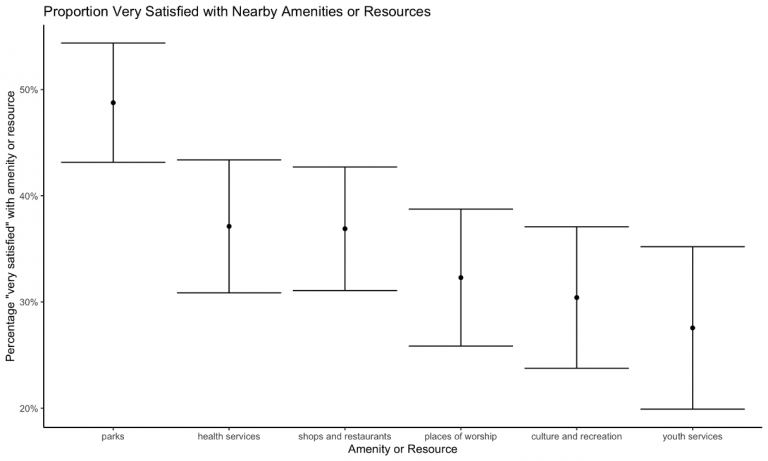Satisfaction with local amenities and resources
Finally, though not directly connected to determining neighbourhood priorities, we also asked two questions about the amenities residents perceive their neighbourhoods to offer and how satisfied they were with them. Specifically, we included questions that asked what amenities/services residents were aware of in their neighbourhood and then asked participants to indicate their satisfaction with these amenities/services. The below figure summarizes the results. Regarding awareness of amenities/services, the major finding was that new Canadians (i.e. Canadians born outside of Canada) generally had the lowest level of knowledge of local amenities and services.
In regards to satisfaction with existing amenities, we found most respondents were satisfied with their local parks and green spaces, with over 50% indicating they are very satisfied with them, though the rate of satisfaction was even higher in the control neighbourhoods. On the other end, residents were far less likely to be very satisfied with their nearby options for culture and recreation or youth services. These are two areas where improvements could have a significant impact on residential satisfaction.
What do you like most about your neighbourhood?
Interviews provided additional opportunities for residents to articulate what features of their current neighbourhoods they value most. Based on a textual analysis of the interviews we were able to identify a set of common themes of priority areas that arose. We also asked a specific open-ended question, “what do you like most about your neighbourhood?” Analyzing this question in specific we noted that very few interviewees were entirely dissatisfied with their neighbourhoods. Only 3 out of 24 said there was nothing to like about where they lived. Contradicting the image of suburbs as often lacking in resources compared to the downtown core, many (11) viewed their neighbourhoods as offering a rich set of amenities, such as libraries, restaurants, parks, shops, tennis courts, universities (University of Toronto Scarborough and York), community centres, or ravines. Nearly as common (9) were references to valuing the convenient access afforded by one’s neighbourhood, whether to travelling downtown, to other suburbs, or to amenities. Similarly, a number of interviewees (7) specifically valued the access to transit their neighbourhoods offer — often relative to their experience of outer suburbs such as Brampton or Vaughn. Finally, others (6) valued the opportunity to interact with diverse ethno-cultural groups, sometimes citing events such as multi-cultural food festivals or diverse shops or restaurants. All in all, the interviewees painted a rich portrait of vibrant inner-suburban communities.
Based on the larger themes and analysis for the ‘what do you like most question’ responses, we were able to identify key focus areas from the qualitative work. Comparing these with the quantitative priority areas, we were able to come to three priority areas and two secondary areas that are elaborated in the following sections. In doing so we paid close attention to priority areas that came up clearly both in the quantitative and qualitative data sets.





